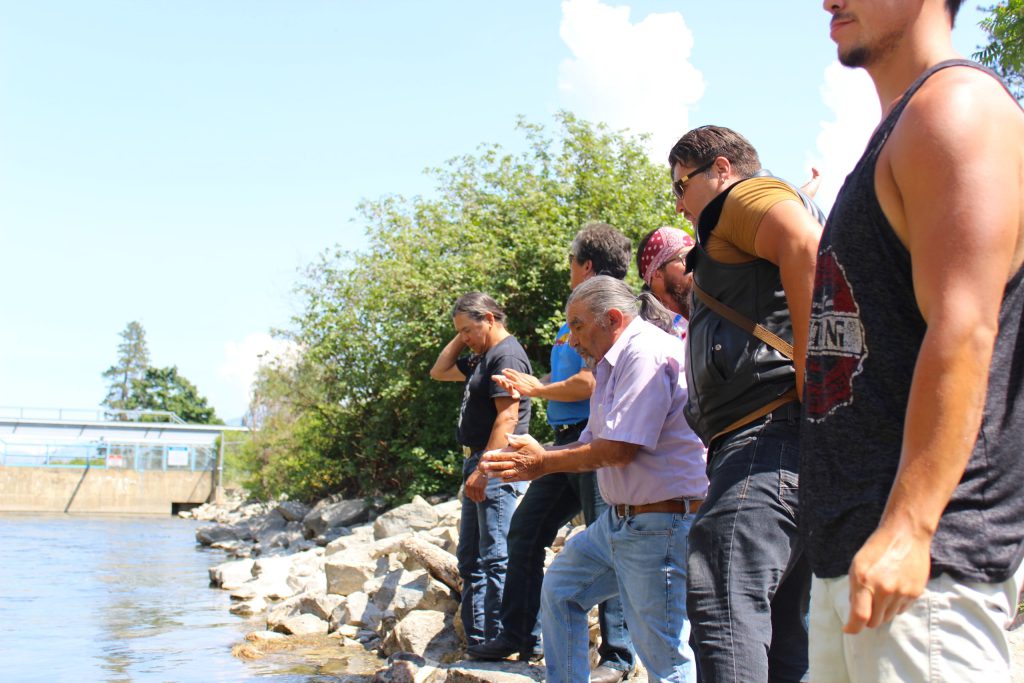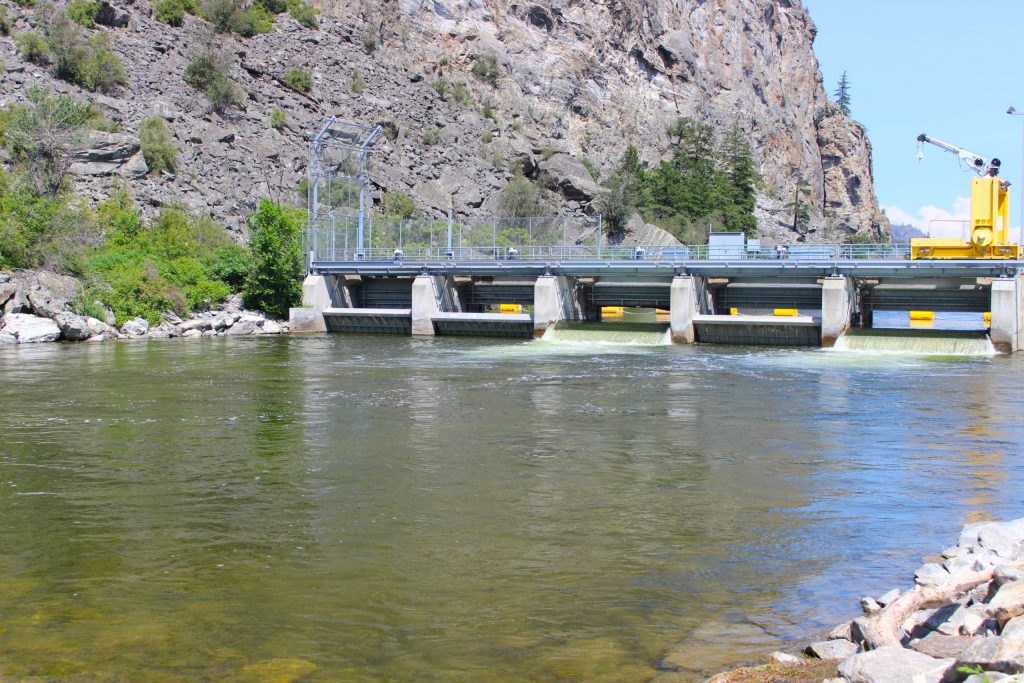Sending prayers for a safe return, five-day ceremony calls salmon home to syilx waters
ONA’s Salmon Calling Ceremony crosses borders to let the fish know ‘we’re still here, the land needs them, we haven’t given up,’ says Elder caylx


Gathering along the riverbank at nʕaylintn (the McIntyre Dam), people said prayers for the return of salmon — part of a five-day Salmon Calling Ceremony that’s hosted by the Okanagan Nation Alliance (ONA) each year.
The event in Oliver on Monday was the second-last stop of the journey, which involves crossing the colonially-imposed border to hold ceremony at five sites along sn̓x̌ʷn̓tkʷítkʷ (the Columbia River) in “B.C.” and “Washington State.”
The event holds deep significance for the syilx Okanagan Nation as part of a commitment to reintroducing and restoring the salmon population back into their waterways.
Each year, the Salmon Calling Ceremony plays a pivotal role in the syilx Peoples’ ongoing efforts to honour their ancestors, while offering prayers for the well-being of the ntytyix (salmon), siwłkʷ (water), tmxʷulaxʷ (land) and tmixʷ (all lifeforms).
caylx (Richard Armstrong), a syilx Elder of the Penticton Indian Band (PIB), emphasized the importance of the Salmon Calling Ceremony, saying: “it’s about regeneration.”
He explained that each location along the river is carefully chosen because of its historical importance as traditional gathering sites for fishing.
“Our science and understanding goes back thousands of years,” caylx said. “And it’s time that we are now being recognized for our knowledge of the way things are, the way things need to be.”
Honouring ancestors, praying for the salmon
caylx said he has been doing the calling back ceremonies since he was 14 and this knowledge has been passed down to him from relatives. These ceremonies are also part of the captikʷl (the documentation of syilx knowledge).
Every ceremony begins with a gathering of people along the riverbanks, clacking two rocks together, uniting in prayer for the safe return of the salmon to their ancestral home.
“Everybody who’s there picks up little rocks and they say their own prayer and their own thoughts with clacking them rocks. They throw the rocks in the water, your prayers are in those little rocks,” he explained.
One of the captikʷl caylx heard when he was younger is about how snk̓lip (coyote) gave the responsibility to the c̓ayx̌aʔ (crayfish) to help call the salmon home.
“The salmon ceremony goes back to a time before there were people, there were only animal people. snk̓lip was the one that brought the salmon up through all of the rivers and all of everywhere,” he said.
This responsibility is symbolized by the distinctive clicking or clacking sound produced by the crayfish pinching their claws together in the water.

“That is the job of c̓ayx̌aʔ, they make that noise if the water’s clean, clear, and good enough for the salmon to lay their eggs in,” he said.
According to caylx, that is the distinctive sound salmon listen for, so that is why the clacking of two rocks together is a unique trait of this ceremony.
“That sound says the water is still here, there’s enough water, the water’s good,” caylx said.
“We know that they’re having a hard time coming back to us, we wanna let them know that we’re still here, the land still needs them, we haven’t given up. That’s what the Salmon Calling Ceremony is: calling them back.”
nʕaylimnt (McIntyre Dam)
Chief Clarence Louie (y̓ilmixʷm ki law na) of the Osoyoos Indian Band (OIB) said nʕaylintn (the McIntyre Dam) was an old reserve site for his community, and so they have a responsibility to care for it.
The McIntyre Dam was built in 1954 to control water flows and facilitate irrigation between Vaseux and Osoyoos lakes — however the installment of the dam long posed a barrier to the upstream journey of the region’s salmon population.
“For 50 years or more the salmon wouldn’t get past McIntyre, only a few would, but not very many. The salmon wouldn’t get to our people,” Louie said.
In 2009, significant upgrades were made to the McIntyre Dam aimed at improving the migration of sockeye salmon in the Okanagan River.
Shaun Reimer, a hydrotechnical engineer with the Ministry of Forests, worked with ONA to modify the dam.
He recalled his early experiences working with the ONA, when he witnessed the cultural significance of salmon and realized he wanted to help to restore populations of the fish.
The key modifications to the McIntyre Dam to accommodate the salmon involved replacing undershot gates to a more fish-friendly design and constructing a backwater riffle to create a resting pool for the salmon and help them to more easily jump.

“The problem before was that the velocity of the water was so much that the fishes couldn’t get through,” said Reimer. “So the changes that we’ve seen now have had tremendous benefits for both the ecosystem and local communities.”
This project not only addressed the historical obstruction faced by the salmon but also opened up 11.5 kilometers of previously inaccessible spawning and rearing habitat in the Okanagan River — a tributary of the Columbia River — and Vaseux Lake.
This historic breakthrough opened up new opportunities for salmon populations to reclaim their natural course and spawn in areas previously inaccessible for decades.
“I’ve seen it with my own eyes, the Okanagan River just filled with salmon spawned. And that never happened for 50 years because of that McIntyre Dam,” said Louie.
“Now they even get past OK Falls into Skaha Lake and they get up to the Penticton reserve now, which they never used to. It’s important that now there are more salmon spawning grounds.”
Reporting for this story was made possible in part through a grant from the Institute for Journalism and Natural Resources and the Gordon and Betty Moore Foundation.
Author
Latest Stories
-
‘Bring her home’: How Buffalo Woman was identified as Ashlee Shingoose
The Anishininew mother as been missing since 2022 — now, her family is one step closer to bringing her home as the Province of Manitoba vows to search for her
-
‘He was full of spirit, promise and love’: Police confirm Samuel Bird is presumed dead as search area narrows
Remains of the 14 year old, whose spirit name is Achakapis, are believed to be ‘no more than 150 km’ from ‘Edmonton,’ according to investigators












